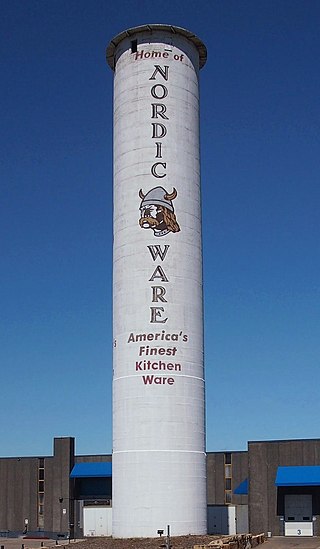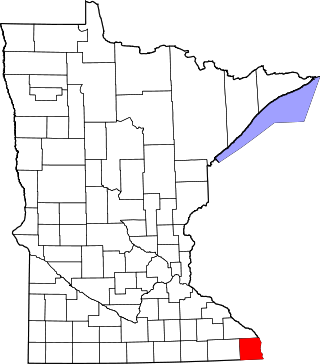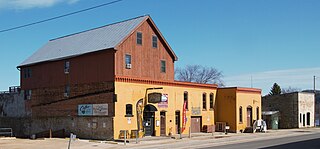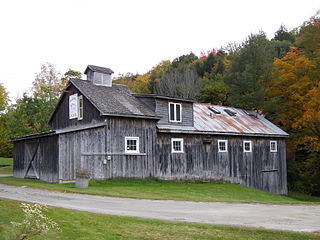
A grain elevator is a facility designed to stockpile or store grain. In the grain trade, the term "grain elevator" also describes a tower containing a bucket elevator or a pneumatic conveyor, which scoops up grain from a lower level and deposits it in a silo or other storage facility.

Lidtke Mill, also known as the Lime Springs Mill Complex, is a historic building located on the Upper Iowa River located in the "Old Town" area of Lime Springs, Iowa, United States. It is part of the 10 acres (4.0 ha) Lidtke Park.

The Peavey–Haglin Experimental Concrete Grain Elevator is the world's first known cylindrical concrete grain elevator. It was built from 1899 to 1900 in St. Louis Park, Minnesota, United States, as an experiment to prove the design was viable. It was an improvement on wooden elevators that were continually at risk of catching fire or even exploding. Its cylindrical concrete design became the industry standard in the United States, revolutionizing grain storage practices. After its initial experiments, the Peavey–Haglin Elevator was never again used to store grain. Since the late 1960s it has been maintained on the grounds of the Nordic Ware company and is painted with their name and logo.

Northwestern Consolidated Milling Company Elevator A also known as the Ceresota Elevator and "The Million Bushel Elevator" was a receiving and public grain elevator built by the Northwestern Consolidated Milling Company in 1908 in Minneapolis, Minnesota in the United States. The elevator may have been the largest brick elevator ever constructed and ran on electricity. The elevator was the source for the Crown Roller Mill and Standard Mill. Those mills closed in the 1950s but the elevator continued in use for grain storage until the mid 1980s. The building is a contributing property of the St. Anthony Falls Historic District listed in the National Register of Historic Places in 1971. For this article north is toward the river.
The Bernhard Warkentin Homestead, also known as Little River Stock Farm or Warkentin Farm, is a historic farm complex on East North Street in Halstead, Kansas. It was listed on the National Register of Historic Places in 1974. It was further declared to be a National Historic Landmark in 1990, nationally significant for its association with Bernhard Warkentin, a pivotal figure in the development and wide cultivation of durum wheat in the country.

The Sheridan Flouring Mills, also known as the Mill Inn, are an industrial complex in Sheridan, Wyoming. The mills were a major component of the economy of north central Wyoming, providing collection, storage and milling of locally produced wheat and other grains into flour and other milled products. The original mill was established by Captain Scott W. Snively in the early 1890s. The Sheridan Milling and Manufacturing Company was sold to J.W. Denio in 1903, who operated the mill at its location on Broadway Avenue near downtown Sheridan. A catastrophic fire destroyed this mill in 1919, resulting in the purchase of a new location on Coffeen Avenue and construction of a much larger mill.

This is a list of the National Register of Historic Places listings in Fillmore County, Minnesota. It is intended to be a complete list of the properties and districts on the National Register of Historic Places in Fillmore County, Minnesota, United States. The locations of National Register properties and districts for which the latitude and longitude coordinates are included below, may be seen in an online map.

This is a list of the National Register of Historic Places listings in Houston County, Minnesota. It is intended to be a complete list of the properties and districts on the National Register of Historic Places in Houston County, Minnesota, United States. The locations of National Register properties and districts for which the latitude and longitude coordinates are included below, may be seen in an online map.
The Krause Milling Co grain elevator and flour mill site complex is composed of a 1929 grain elevator, drive shed, office/powerhouse, storage building and foundation of the 1929 flour mill, in the center of Radway, Alberta.

Hanford Mills Museum, also known as Kelso Mill, is a historic grist mill and sawmill and national historic district located at East Meredith, New York in Delaware County, New York. The district contains nine contributing buildings and three contributing structures. The complex includes both natural and structural facilities. It includes a mill race from Kortright Creek to the damned up Mill Pond which supplies the waterwheel, a spillway for the pond's overflow, a section of old (1900) New York Central Railroad track, two railroad bridges crossing Kortright Creek, and a variety of buildings. The main structure is a mill building dating to the 1820s with additions from the 1870s, 1880s, and 1890s. The four story wood-frame structure is approximately 150 feet long and 120 feet high. Also on the property is a one-story depot building with grain elevator and storage facilities. It is now operated as a museum. It was listed on the National Register of Historic Places in 1973.

Mill City Museum is located in the ruins of the Washburn "A" Mill next to Mill Ruins Park on the banks of the Mississippi River in Minneapolis. The museum, an entity of the Minnesota Historical Society that opened in 2003, focuses on the founding and growth of Minneapolis, especially flour milling and the other industries that used hydropower from Saint Anthony Falls. The mill complex that the museum is within, dates from the 1870s and is listed on the National Register of Historic Places. It is also part of the St. Anthony Falls Historic District and within the Mississippi National River and Recreation Area.

American Grain Complex, also known as "The American", Russell-Miller Milling Co. Elevator, and Peavey Co. Elevator, is a historic grain elevator and flour milling complex located in South Buffalo, Buffalo, Erie County, New York. The complex consists of three contributing buildings and two contributing structures. They are the Elevator Building, Flour Building (1906-1924), office building, Moveable Marine Tower, and railroad tracks. The Elevator Building consists of the mainhouse, workhouse, and fixed marine tower, all built in 1905–1906, and an annex constructed in 1931. The complex was last owned by ConAgra Foods, who closed the elevator and mill in June 2001.
The Baker Woodframe Elevator was a historic grain elevator in Baker, Oklahoma. The wood frame elevator was built for the Kimber Milling Company in 1926. The elevator was located at the intersection of the Chicago Rock Island and Pacific and the Beaver, Meade and Englewood. The railroad shipped wheat harvested in Baker to the Gulf Coast. The elevator operated until 1974, when the railroads ended their service to Baker. No remains of this elevator are evident. It existed just north of another elevator built in the 1970s that still remains.

Dial Mill is a historic gristmill and flour mill outside of Conyers, Georgia. It was added to the National Register of Historic Places on April 6, 1977.

The Queen Bee Mill is a ruined mill complex located in Falls Park in Sioux Falls, South Dakota. Opened in 1881, the mill operated intermittently for several different owners during the late nineteenth and early twentieth centuries. A 1956 fire led to the site's demolition, leaving the ruins that stand today. The mill site is listed on the National Register of Historic Places.

G. Kerndt and Brothers Elevator and Warehouses, No. 11, No.12 and No. 13 is a historic complex located in Lansing, Iowa, United States. The four Kerndt brothers were all German immigrants who settled in the Lansing area by 1854. Gustav, William and Mortiz established a broom factory and cigar business in town while Herman farmed and provided the broom corn for the factory. A fifth brother, Julian, died shortly after arriving in Iowa. They built their first grain warehouse in the late 1850s. In 1861 they began their general store, which would in time include private banking as a part of their mercantile business. In 1908 it was incorporated by the family as the Kerndt Brothers Savings Bank.

The Old Red Mill is a historic mill complex at Vermont Route 12 and Lovers Lane in southern Northfield, Vermont. Built in 1898, the building houses a nearly intact water-powered grain grinding mechanism from the period. It was listed on the National Register of Historic Places in 1977.

The Old Red Mill and Mill House are a historic 19th-century mill building and residence on Red Mill Drive in Jericho, Vermont. The mill was built in 1856 and enlarged later in the 19th century, accommodating then state-of-the art grain rollers, and was a prominent local business. The house was built in 1859, and is a good local example of Gothic Revival architecture. The mill is now a museum property of the local Jericho Historical Society. The mill building was listed on the National Register of Historic Places in 1972; the listing was expanded to include the house in 1976.

The W. R. Stafford Flour Mill and Elevator was a mill located at 4310 Huron Street in Port Hope, Michigan. It was listed on the National Register of Historic Places in 1987 and demolished in the early 2000s.
The Turpin Grain Elevator, located off U.S. Route 64 in Turpin, Oklahoma, was built in 1925. It was listed on the National Register of Historic Places in 1983.


















